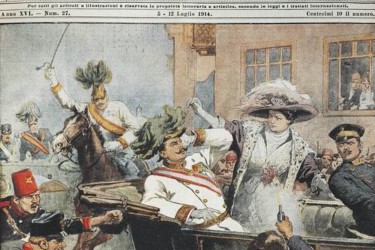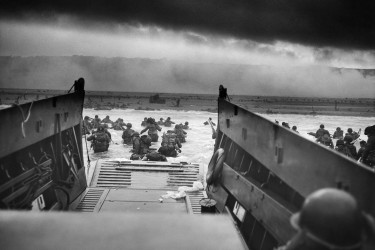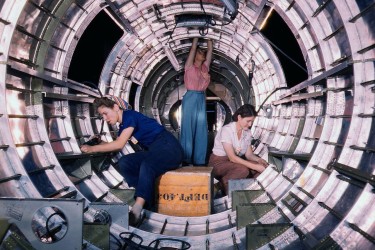This year will mark the passing of a full century since the end of World War I—a hundred years since the “War to End All Wars.” In that time, much of the battle-ravaged landscape along the Western Front has been reclaimed by nature or returned to farmland, and the scars of the war are disappearing. Some zones remain toxic a century later, and others are still littered with unexploded ordnance, closed off to the public. But across France and Belgium, significant battlefields and ruins were preserved as monuments, and farm fields that became battlegrounds ended up as vast cemeteries. In these places, the visible physical damage to the landscape remains as evidence of the phenomenal violence and destruction that took so many lives so long ago.
The History of History
Colonial Era
View Connections20The History of History
World Wars
The Fading Battlefields of World War I
A collection of photographs that show nature retaking the battle-ravaged land along the Great War's Western Front.
The Founding
View Connections20The History of History
World Wars
The Fading Battlefields of World War I
A collection of photographs that show nature retaking the battle-ravaged land along the Great War's Western Front.
This year will mark the passing of a full century since the end of World War I—a hundred years since the “War to End All Wars.” In that time, much of the battle-ravaged landscape along the Western Front has been reclaimed by nature or returned to farmland, and the scars of the war are disappearing. Some zones remain toxic a century later, and others are still littered with unexploded ordnance, closed off to the public. But across France and Belgium, significant battlefields and ruins were preserved as monuments, and farm fields that became battlegrounds ended up as vast cemeteries. In these places, the visible physical damage to the landscape remains as evidence of the phenomenal violence and destruction that took so many lives so long ago.
Slavery & Emancipation
View Connections20The History of History
World Wars
The Fading Battlefields of World War I
A collection of photographs that show nature retaking the battle-ravaged land along the Great War's Western Front.
This year will mark the passing of a full century since the end of World War I—a hundred years since the “War to End All Wars.” In that time, much of the battle-ravaged landscape along the Western Front has been reclaimed by nature or returned to farmland, and the scars of the war are disappearing. Some zones remain toxic a century later, and others are still littered with unexploded ordnance, closed off to the public. But across France and Belgium, significant battlefields and ruins were preserved as monuments, and farm fields that became battlegrounds ended up as vast cemeteries. In these places, the visible physical damage to the landscape remains as evidence of the phenomenal violence and destruction that took so many lives so long ago.
Civil War & Reconstruction
View Connections20The History of History
World Wars
The Fading Battlefields of World War I
A collection of photographs that show nature retaking the battle-ravaged land along the Great War's Western Front.
This year will mark the passing of a full century since the end of World War I—a hundred years since the “War to End All Wars.” In that time, much of the battle-ravaged landscape along the Western Front has been reclaimed by nature or returned to farmland, and the scars of the war are disappearing. Some zones remain toxic a century later, and others are still littered with unexploded ordnance, closed off to the public. But across France and Belgium, significant battlefields and ruins were preserved as monuments, and farm fields that became battlegrounds ended up as vast cemeteries. In these places, the visible physical damage to the landscape remains as evidence of the phenomenal violence and destruction that took so many lives so long ago.
American Indians
View Connections20The History of History
World Wars
The Fading Battlefields of World War I
A collection of photographs that show nature retaking the battle-ravaged land along the Great War's Western Front.
This year will mark the passing of a full century since the end of World War I—a hundred years since the “War to End All Wars.” In that time, much of the battle-ravaged landscape along the Western Front has been reclaimed by nature or returned to farmland, and the scars of the war are disappearing. Some zones remain toxic a century later, and others are still littered with unexploded ordnance, closed off to the public. But across France and Belgium, significant battlefields and ruins were preserved as monuments, and farm fields that became battlegrounds ended up as vast cemeteries. In these places, the visible physical damage to the landscape remains as evidence of the phenomenal violence and destruction that took so many lives so long ago.
Feminism & Women's Rights
View Connections20The History of History
World Wars
The Fading Battlefields of World War I
A collection of photographs that show nature retaking the battle-ravaged land along the Great War's Western Front.
This year will mark the passing of a full century since the end of World War I—a hundred years since the “War to End All Wars.” In that time, much of the battle-ravaged landscape along the Western Front has been reclaimed by nature or returned to farmland, and the scars of the war are disappearing. Some zones remain toxic a century later, and others are still littered with unexploded ordnance, closed off to the public. But across France and Belgium, significant battlefields and ruins were preserved as monuments, and farm fields that became battlegrounds ended up as vast cemeteries. In these places, the visible physical damage to the landscape remains as evidence of the phenomenal violence and destruction that took so many lives so long ago.
World Wars
View Connections17The History of History
World Wars
The Fading Battlefields of World War I
A collection of photographs that show nature retaking the battle-ravaged land along the Great War's Western Front.
This year will mark the passing of a full century since the end of World War I—a hundred years since the “War to End All Wars.” In that time, much of the battle-ravaged landscape along the Western Front has been reclaimed by nature or returned to farmland, and the scars of the war are disappearing. Some zones remain toxic a century later, and others are still littered with unexploded ordnance, closed off to the public. But across France and Belgium, significant battlefields and ruins were preserved as monuments, and farm fields that became battlegrounds ended up as vast cemeteries. In these places, the visible physical damage to the landscape remains as evidence of the phenomenal violence and destruction that took so many lives so long ago.
Civil Rights Movement
View Connections20The History of History
World Wars
The Fading Battlefields of World War I
A collection of photographs that show nature retaking the battle-ravaged land along the Great War's Western Front.
This year will mark the passing of a full century since the end of World War I—a hundred years since the “War to End All Wars.” In that time, much of the battle-ravaged landscape along the Western Front has been reclaimed by nature or returned to farmland, and the scars of the war are disappearing. Some zones remain toxic a century later, and others are still littered with unexploded ordnance, closed off to the public. But across France and Belgium, significant battlefields and ruins were preserved as monuments, and farm fields that became battlegrounds ended up as vast cemeteries. In these places, the visible physical damage to the landscape remains as evidence of the phenomenal violence and destruction that took so many lives so long ago.
Capitalism & Class
View Connections20The History of History
World Wars
The Fading Battlefields of World War I
A collection of photographs that show nature retaking the battle-ravaged land along the Great War's Western Front.
This year will mark the passing of a full century since the end of World War I—a hundred years since the “War to End All Wars.” In that time, much of the battle-ravaged landscape along the Western Front has been reclaimed by nature or returned to farmland, and the scars of the war are disappearing. Some zones remain toxic a century later, and others are still littered with unexploded ordnance, closed off to the public. But across France and Belgium, significant battlefields and ruins were preserved as monuments, and farm fields that became battlegrounds ended up as vast cemeteries. In these places, the visible physical damage to the landscape remains as evidence of the phenomenal violence and destruction that took so many lives so long ago.
Cold War
View Connections20The History of History
World Wars
The Fading Battlefields of World War I
A collection of photographs that show nature retaking the battle-ravaged land along the Great War's Western Front.
This year will mark the passing of a full century since the end of World War I—a hundred years since the “War to End All Wars.” In that time, much of the battle-ravaged landscape along the Western Front has been reclaimed by nature or returned to farmland, and the scars of the war are disappearing. Some zones remain toxic a century later, and others are still littered with unexploded ordnance, closed off to the public. But across France and Belgium, significant battlefields and ruins were preserved as monuments, and farm fields that became battlegrounds ended up as vast cemeteries. In these places, the visible physical damage to the landscape remains as evidence of the phenomenal violence and destruction that took so many lives so long ago.
The Rise of Trump
View Connections20The History of History
World Wars
The Fading Battlefields of World War I
A collection of photographs that show nature retaking the battle-ravaged land along the Great War's Western Front.
This year will mark the passing of a full century since the end of World War I—a hundred years since the “War to End All Wars.” In that time, much of the battle-ravaged landscape along the Western Front has been reclaimed by nature or returned to farmland, and the scars of the war are disappearing. Some zones remain toxic a century later, and others are still littered with unexploded ordnance, closed off to the public. But across France and Belgium, significant battlefields and ruins were preserved as monuments, and farm fields that became battlegrounds ended up as vast cemeteries. In these places, the visible physical damage to the landscape remains as evidence of the phenomenal violence and destruction that took so many lives so long ago.
















